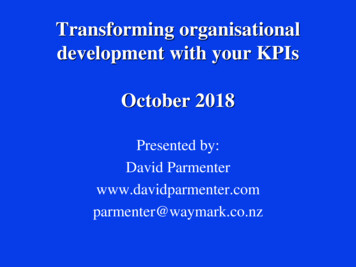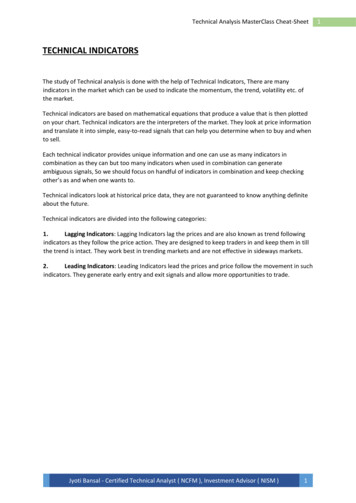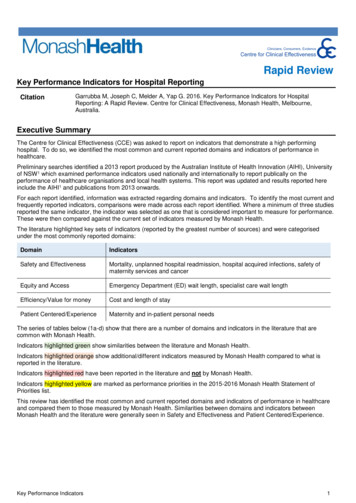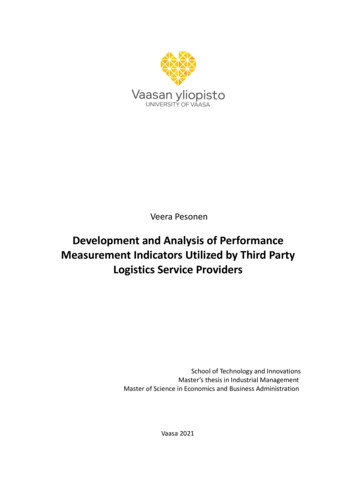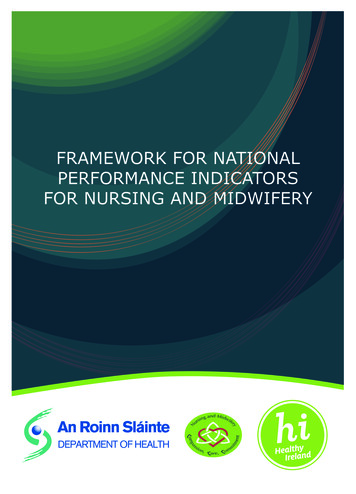
Transcription
FRAMEWORK FOR NATIONALPERFORMANCE INDICATORSFOR NURSING AND MIDWIFERY
FRAMEWORK FOR NATIONALPERFORMANCE INDICATORSFOR NURSING AND MIDWIFERY3
CONTENTSFOREWORD BY THE MINISTER FOR HEALTHFOREWORD BY THE CHIEF NURSING OFFICERSECTION 1 — INTRODUCTION1.1 What is the purpose of this Framework?081.2 How will this Framework benefit the health service user?081.3 Performance measurement081.4 What are PIs? 081.5 Why do we need Health Service PIs?081.6 Why do we need specific Nursing and Midwifery PIs?081.7 Why do we need National Nursing and Midwifery PIs?111.8 What is the policy context of this Framework?12SECTION 2 — FRAMEWORK FOR NATIONAL PERFORMANCE INDICATORS FORNURSING AND MIDWIFERYSECTION 2. PART A — MINIMUM DATA SET2.A.1What is a Minimum Data Set?142.A.2What is a Nursing Minimum Data Set?142.A.3Why is a minimum data set required for the nursing and midwifery workforce142.A.4Nursing and midwifery workforce registry152.A.5Developing Minimum Data Sets for PIs16SECTION 2. PART B — PERFORMANCE INDICATORS2.B.1Evidence Review192.B.2Types of indicators202.B.3Considerations 222.B.4Governance232.B.5Performance Indicator Prioritisation and Endorsement Process242.B.6What makes a good indicator?254
2.B.7Matrix of National Nursing and Midwifery PIs262.B.8Process for developing the PIs282.B.9Pilot Test Performance Indicators312.B.10 Determine review frequency312.B.11 What are Metadata? 312.B.12 Data Reporting312.B.13 Tracking Performance Indicators312.B.14 Conclusion32SECTION 3 — REFERENCES AND APPENDIX3.1 References333.2 Appendix 1355
FOREWORD BY THE MINISTER FOR HEALTHOver the years, we have developed the nursing and midwifery professions and rightly so.Significant investment has been made and it’s important that we demonstrate its effect.It is vital, therefore, that we measure the outcomes and contribution of nursing and midwiferyinterventions and initiatives on client/patient care. This framework will assist in demonstratingthe impact of nursing and midwifery across key areas of our health services, through the useof performance indicators.Currently, we have limited data on the nursing and midwifery workforce to inform workforceplanning, service planning, recruitment and retention, training and development, and disasterand emergency planning. Therefore, the first priority action from this framework is thedevelopment of a minimum data set for the nursing and midwifery workforce.Once the minimum data set is implemented, we will know the accurate number of nurses andmidwives employed in our health services.The significance of this work cannot be underestimated in facilitating the management of thehealth services and the development of performance indicators for nursing and midwifery.The use of performance indicators will further embed an ethos of performance improvement innursing and midwifery and help both professions to make visible their contribution to a cultureof quality and safe patient care.Simon Harris TDMinister for Health6
FOREWORD BY THE CHIEF NURSING OFFICERI am delighted to introduce this Framework for National Performance Indicators for Nursing andMidwifery.In 2010, the Health Information and Quality Authority (HIQA) published guidance on thedevelopment of key performance indicators in health care. This framework builds on thatguidance but is tailored to nursing and midwifery and captures issues that predominate innursing and midwifery services.The Strategy for the Office of the Chief Nursing Officer 2015–2017 contains a suite of integratedpolicies that are designed to revolutionise the way nursing and midwifery services will bedelivered in the future. The performance indicators developed and endorsed for use at nationallevel, as a result of this framework, will be incorporated in the HSE National Service Plan andwill measure the impact of these and other policies.I am confident that by implementing this framework, we will be able to unambiguouslydemonstrate the magnitude of the nursing and midwifery contribution to the health service.I look forward to working with all of our partners, particularly the HSE and NMBI, and other keystakeholders to implement this framework.Dr Siobhan O’HalloranChief Nursing Officer7
SECTION 1 — INTRODUCTION1.1 What is the purpose of this Framework?The purpose of this Framework is to (i) set out the policy context for the use of nursing and midwifery performanceindicators (PIs) to demonstrate the relationship between inputs and outcomes/impact; (ii) provide guidance on PIsincluding clarifying the relationship between Structure, Process and Outcome PIs; and (iii) ensure that there is astandardised approach to their development, prioritisation, endorsement and implementation.1.2 How will this Framework benefit the health service user?All nursing and midwifery policy is developed with the aim of meeting the needs of the health service user. PIs willtell us whether or not we are achieving our policy objectives.1.3 Performance measurementPerformance measurement in healthcare settings has become very important in recent years as a way of ensuringthat the delivery of health services is improving all the time. The Irish health service requires significant fundingand performance measurement is one tool used to inform the allocation of resources in a way that facilitates theachievement of policy objectives. It also allows healthcare settings to assess and continually improve their ownperformance and compare it to similar settings.1.4 What are PIs?PIs are measures of performance that are used by organisations to measure how well they are performing againsttargets or expectations. PIs measure performance by showing trends to demonstrate that improvements are beingmade over time. PIs also measure performance by comparing results against standards or other similar organisations.This helps organisations to improve the service they provide by identifying where performance is at the desired leveland also identifying where improvements are required. Performance measurement promotes accountability to allstakeholders, including the public, service users, clinicians and the Government. It does this by facilitating informeddecision-making and safe, high quality and reliable care through monitoring, analysing and communicating thedegree to which organisations meet key goals (HIQA, 2010, updated 2013). There are three types of PIs: Structure,Process and Outcome and these are explored in further detail in 2.B.2.1.5 Why do we need Health Service PIs?In the health service, information plays a pivotal role in promoting improvements in the safety and quality of clientcare. The delivery of care that is safe, client-centred, compassionate, effective and efficient is the responsibility ofall health care professionals (HSE, 2015) and requires information that is of good quality, comparable and can beshared within the health sector.Health service PIs identify good practice and provide comparability within and between similar services. They alsoidentify opportunities for improvement and the need for a more detailed investigation of standards. The ultimate goalof PIs is to contribute to the provision of a high quality, safe and effective service that meets the needs of serviceusers (HIQA, 2010, updated 2013).1.6 Why do we need specific Nursing and Midwifery PIs?PIs for nursing and midwifery identify specific and measurable elements of the quality and quantity of nursing andmidwifery care provided. Nursing and midwifery care is critical to achieving positive client outcomes and PIs areneeded to evaluate nursing interventions and implement initiatives to improve quality and quantity. They are alsoimportant in providing accountability and assurance to the public (Skills for Health, 2016). In addition, they identifyareas of good practice that must be recognised and celebrated (HSE, 2015).Nursing and midwifery care is delivered in a complex environment and there are multiple factors that influencenursing and midwifery practice as indicated by the National Council for the Professional Development of Nursing andMidwifery (June 2010) in the following figure (Figure 1):8
text and enial conviroconmr s Values Demographicseend h &evidenceAccountabilityKnowledgeExpertiseocial carend sseattinthAdministratorsalHealth professionals Lay carersRPNRCNRNIDgHeSkillsResourcesprinciples; conceptSafetysalBelief SystemssionsNormsofePolicyPr Caring EthicsQuality Team workingRPHNRMRGNPatients;selection ofinterventions;outcomesGiven this complex environment, it is important to develop PIs that capture the contribution made specifically bynurses and midwives to the health service. When it comes to the development of these PIs, Griffiths et al. (2008)state that the aim is to “ identify a relatively small number of indicators that still relate clearly to the multifacetedand somewhat elusive concept of quality nursing care”.Evidence shows that the nurse staffing and skill mix resource has a direct impact on patient and staff outcomes(Aiken et al., 2014), so it’s vital to be able to demonstrate the benefits for patients of investment in this resource.The pay for nursing in 2015 was 2.2 billion¹. However, the total cost of the nursing and midwifery resource includesadditional costs, for example, education and regulation costs.The Health Service Personnel Census shows that nursing (including midwifery) is the largest staff category in thepublic health service accounting for almost 34% of all staff:¹ This figure includes both statutory and section 38 agencies.9
Table 1Number (WTE) of staff employed in the public health service, as at July 2016Staff CategoryWTE (excld. careerbreak)Medical/Dental% of Total9,356.628.86Nursing35,712.3633.81Health & Social Care al Support StaffPatient & Client CareTotalSince the publication of The Report of the Commission on Nursing in 1998, there has been significant investment innursing and midwifery initiatives including: the appointment of the Chief Nursing Officer at Assistant Secretary level in the Department of Health andthe establishment of the CNO’s Office;the location of undergraduate nursing and midwifery education in the universities and higher educationsector;the enactment of legislation and regulation giving prescriptive authority to nurses and midwives;the enactment of the Nurses and Midwives Act 2011;the development of career pathways, to enable role expansion across clinical management and educationdimensions; andthe establishment of a national structure for leading and implementing the development of capacity andcapability within the nursing and midwifery workforce.The Commission on Nursing enabled significant developments in the nursing and midwifery resource and themonitoring of PIs is essential to demonstrate the contribution of the professions to safe patient care. This can beachieved through the use of nursing and midwifery PIs at both national and local levels.The HSE introduced process PIs in the form of Quality Care Metrics (QCM). A range of organisations (across acutehospitals, midwifery, children’s, older persons, intellectual disability, mental health services and public health/community nursing services) currently gather data on a monthly basis that provide an indication of care qualityaligned to evidenced based standards, policies and procedures. The HSE is currently identifying a new suite of QCMusing a robust academic evidence-based framework that will determine a range of new process measures sensitiveto the influences of nurses and midwives and agreed through national consensus. This work is aligned to the policydirection of the CNO’s Office and this Framework.The Office of the Nursing and Midwifery Service Director (ONMSD) (2015) in the HSE highlights the benefits ofnursing and midwifery QCM as a measuring system that: monitors and assesses performance against evidenced based standards;quantifies trends and characteristics;highlights exceptional care and areas of risk which require immediate attention;provides a standardised system to track and benchmark the quality of care;10
offers direction on educational needs for healthcare staff; andpromotes staff engagement and accountability for the quality of care.It adds that in addition to providing real time information to nurses and midwives about how clients are benefitingfrom quality care delivery, QCM data enables managers to monitor individual ward performance and organisationalprogress in delivering safer, quality focused client care.VanDeVelde-Coke et al. (2012) conclude that “Equipped with the right information, nurses can better demonstratetheir value, advocate for the impact their profession has on the entire system, and focus their efforts on those factorsthat have the greatest effect on healthcare outcomes, confirming that nurses make a difference”.1.7Why do we need National Nursing and Midwifery PIs?National nursing and midwifery PIs are needed to evaluate the implementation and effectiveness of policy and toshow the impact of the investment in nursing and midwifery at a national level. The first step in this pathway (Figure2) is to continue to embed the core values of nursing and midwifery practice, i.e., Compassion, Care and Commitment(Department of Health, 2016). Then, the nursing and midwifery resource must be stabilised using the Frameworkfor Safe Nurse Staffing and Skill Mix. This aims to apply a consistent method to determine optimum nurse staffingand skill mix levels. Nursing and midwifery outputs/outcomes will be maximised by deploying staff appropriately andmaximising their scope of practice. Finally, PIs will be used to measure the impact of these initiatives, informed byquality assured nursing and midwifery data. Figure 2:Quality Assured Nursing and Midwifery DataMeasure ImpactNursing and Midwifery PlsDeployappropriately/maximisescope of parcticeMaximiseOutput/OutcomesFramework for Safe NurseStaffing and Skill MixStabilise ResourceEmbed Nursing andMidwifery ValuesCompassion, Care,CommitmentNational PIs are also needed to allow for benchmarking between hospitals or other healthcare settings. However,currently there is a lack of quality assured nursing and midwifery data with which to plan the nursing and midwiferyresource to optimise client care.11
1.8What is the policy context of this Framework?The following figure (Figure 3) shows the position of this Framework in the context of overall policy: WHO Health 2020WHO European Startegic Directions forstrengthening Nursing and MidwiferyTowards Health 2020 Goals Patient SafetyPay and Numbers StrategyFramework for Safe Nursing Staffing andSkill Mix in General and Specialist Medicaland Surgical Care Settings in AdultHospitals in IrelandFuture nursing and midwifery in thecommunity capable of driving integrationof primary care and acute nursing andmidwifery servicesFuture development of advanced andspecialist nursing and midwifery practiceCode of Practice for the Governance ofState BodiesStrategy for the Office of the ChiefNursing Officer 2015-2017Department of Health Statementof Strategy 2016-2019Department of Health Frameworkfor Service Plan KPIsFramework for National PerformaanceIndicatos for Nursing and MidwiferyThe Strategy for the Office of the Chief Nursing Officer was informed by the Department’s Statement of Strategy andrelevant World Health Organisation (WHO) reports (Health 2020 and European Strategic Directions for StrengtheningNursing and Midwifery Towards Health 2020 Goals).It contains four strategic objectives as follows: To provide expert policy input and direction to support government priorities and to optimise publicinvestment in the health system;To strengthen the role of nurses and midwives by optimising the scope of practice across the health service;To enhance the impact of nurses and midwives and demonstrate this through the utilisation of robust dataintelligence;To enable nurses and midwives to serve as full partners in health care design and improvement by enhancingleadership, competency and opportunities.The development of this Framework is one of the priority actions cited in the Strategy and it will facilitate theachievement of the aforementioned strategic objectives. This Framework has been developed in line with theDepartment’s Framework for Service Plan KPIs and in consultation with the ONMSD in the HSE.In addition, it will assist in monitoring the impact of relevant policies on: patient safety (National Patient Safety Office);workforce planning (Pay and Numbers Strategy; and Framework for Safe Nurse Staffing and Skill Mix inGeneral and Specialist Medical and Surgical Care Settings in Adult Hospitals in Ireland);nursing and midwifery (Future nursing and midwifery models in the community capable of driving integrationof primary care and acute nursing and midwifery services, and Future development of advanced andspecialist nursing and midwifery practice); and12
regulation (Code of Practice for the Governance of State Bodies).In other countries, PIs are contained within overarching frameworks for assessing the performance of the healthsystem. Within these frameworks, PIs are categorised under health system goals (and/or domains or dimensions ofperformance). There is currently no analogous health system performance framework in Ireland. Therefore, nationalnursing and midwifery PIs should be categorised under the strategic objectives set out in the Department of Health’sStatement of Strategy 2016–2019: Support people to lead healthy and independent lives;Ensure the delivery of high quality and safe health and social care;Create a more responsive, integrated and people-centred health and social care service;Promote effective and efficient management of the health services;Develop a high-performing Department to lead and oversee the health and social care sector.This format will maintain the flexibility required to measure the impact of nursing and midwifery policy as thepreferred model of care emerges.13
SECTION 2 — FRAMEWORK FOR NATIONALPERFORMANCE INDICATORS FOR NURSING ANDMIDWIFERYSECTION 2. PART A — MINIMUM DATA SET2.A.1 What is a Minimum Data Set?A data set is a set of data that is collected for a specific purpose and a minimum data set (MDS) is the core dataidentified as the minimum required for that purpose. Once PIs have been developed, it is necessary to determinewhat data needs to be collected for each PI being used to measure performance. This should be achieved by creatinga minimum data set and be based on what data are feasible to collect. (HIQA 2010, updated 2013)2.A.2 What is a Nursing Minimum Data Set?A nursing² minimum data set (NMDS) provides a formal structure for electronic data sets to support nursing andmidwifery care in all settings. What distinguishes it from other healthcare data sets is the inclusion of nursingcare elements, i.e., nursing diagnoses, interventions and nursing outcomes (National Council for the ProfessionalDevelopment of Nursing and Midwifery, 2009).According to Werley et al. (1991), the purpose of a NMDS is to: establish comparability of nursing data across clinical populations, settings, geographic areas, and time;describe the nursing care of patients/clients and their families in a variety of settings, both institutional andnon-institutional;demonstrate or project trends regarding nursing care provided and the allocation of nursing resources topatients/clients according to their health problems or nursing diagnoses;stimulate nursing research through links to the detailed data existing in nursing information systems andother health care information systems; andprovide data about nursing care to influence clinical, administrative, and health policy decision-making.2.A.3 Why is a minimum data set required for the nursing and midwiferyworkforce?Currently, there is a dearth of data on nursing and midwifery in the Irish health system and there is no NMDS. Themost important NMDS is a MDS for the nursing and midwifery workforce. Such a MDS would ensure the availabilityof quality assured data for forecasting and budgeting; distribution of the workforce; training and development; andrecruitment and retention (World Health Organisation, 2015).In addition, this MDS would allow for the identification of cohorts of nurses and midwives with specialist skills foremergency or disaster planning. It would also enhance the accuracy of reporting on our nursing/midwifery workforceto international organisations such as the OECD.The WHO (2015) describes a health workforce registry as a critical component of the Human Resources for HealthInformation System (as shown in the following figure (Figure 4)) which in turn is vital to any Health InformationSystem.² The extracts referenced here do not specifically mention midwifery, however, for the purpose of this document ‘nursing’ should be read as ‘nursing and midwifery’.14
Functional Components of Human Resources forHealth (HRH) Information SystemWORKFORCEPRODUCTIONVACANCY EPAYROLLHRHWORKFORCEREGISTRYREGISTRATIONAND LISTENINGBENEFITSTRAININGRETIREMENT2.A.4 Nursing and midwifery workforce registryAll nurses and midwives who practise in Ireland must, by law, be listed on the Register of Nurses and Midwives whichis maintained by the Nursing and Midwifery Board of Ireland (NMBI). This means the register is the ideal placeto collect data on the nursing and midwifery workforce (both in both public and private sectors). The data will beconveniently collected from registrants upon their first registration or renewal of registration. The following is anexample of a minimum data set ³, 4 for the nursing and midwifery workforce: Identification numberNameGenderDate of birthPlace of birthHome addressPhone numberEmail addressLanguageCountry of primary nursing/midwifery qualificationCountry of trainingYear of first registration in IrelandHighest level of education/training completed to date applicable to nursing/midwifery practiceDivision of the register: General; Midwives; Children’s; Psychiatric; Intellectual Disability; Public Health;Nurse Tutor; Nurse Prescribers; Advanced Nurse Practitioners; Advanced Midwife PractitionersDivision of the register in which you are practicingSpecialist qualificationsEmployed/Unemployed/Employed but not working in healthcare/RetiredEmployed full-time/part-time/temporary/contract basis/agencyEmployment sector: Public/Private/VoluntaryEmployment setting: Primary Care/Acute Care/Social CareEmployment type: clinical rch/regulation/sales/Other(Please specify)GradeName of place of employmentAddress of place of employmentThis process will be simplified for registrants through the provision of dropdown options and definitions of terms.The data set will be agreed by key stakeholders (Department of Health (CNO’s Office, Research & Development andHealth Analytics Unit); HSE; and the NMBI)) who will specify their data requirements and the purpose/use of data.³ The WHO (2015) recommends the following MDS: Identification Number; Full name; Birth history, Citizenship, Country of Residence, andLanguage; Address; Contact Information; Education, Professional Licence, and Certification; Employment Status; Employment Address.The Department of Health (2002) recommends the following MDS: Health Board/Authority Region; Place of Employment; Work Address/Assignment; Sex; Date of Birth; Nationality; An Bord Altranais (Irish Nursing Board) Personal Identification Number; Grade/Job Title; Position Title(local title); Commitment; Contract; Registrable Qualifications; and Academic Qualifications.415
2.A.5 Developing Minimum Data Sets for PIsA minimum data set should be developed based solely on the essential data required to operationalise a PI. As datacollection can involve the use of additional resources it is essential that only the minimum amount of data, requiredto enable effective decision making, is collected (HIQA, 2010, updated 2013).The MDS should be developed using the following steps (Table 2), adapted from the HIQA guidance (2010, updated2013):1. Define thelevel of healthinformationIdeally, the required data should be collected as part of routine service delivery.Whether or not the available data meets the requirements of the measurementprocess should have been determined during feasibility testing. If requirementsare not met there will be a need to collect additional data.Data are routinely collected during the delivery of healthcare in order to managecare. These data are then processed at different levels within the healthcaresystem according to the needs of the system and the purpose of the informationas follows: episode-level: which is necessary to facilitate the management of care foreach individual service contact. Episode level data records details of a serviceuser’s journey through the health service and includes data such as sociodemographic details, referral details, and clinical details. Episode level dataare based on the concept of an ‘episode of care’ which commences at the firstcontact with the service and is a means of describing and recording relevantinformation in relation to the care provided to an individual service user duringa defined period of time. A unique identifier for individuals is necessary in orderto report episode-level informationcase-level: which is necessary to facilitate the management of care for eachindividual service user. Case-level data are an aggregate of all the episodesan individual service user has during a reporting period and is derived fromepisode level datafacility-level: which is necessary to facilitate the management of the servicefacility. Facility-level data includes data relating to the facility such as numberof beds, staffing, expenditure and also includes episode-level and case-leveldatasystem-level: which is necessary for policy and planning purposes on a systemwide or national basis. System-level data are an aggregate of all data elementsin a particular region and is derived from episode, case and facility-levelinformation.Frequently, the PI will require data to be processed from different levels, using acombination of data during analysis, to achieve a measurement.2. Define thefrequency ofcollectionThe urgency of decisions to be made based on the PI or the level of monitoringrequired, will determine the frequency of data collection.16
3. Documentthe datacollectionprocessIt is necessary to write detailed data collection specifications to ensure that dataare collected and measured consistently and to reduce the risk of bias. Thereshould be a data development process which results in data standards that contribute to a consistent approach to data collection and use. Data standards areagreements on the representation, format, and definition of common data. Thesedata standards will then assist in the process of ensuring data collection is of highquality and enable consistent and comparable reporting of data and information.Data can be collected manually, electronically or a combination of both. Methodsof data collection need to be explored to determine the feasibility of the PI andanswer the following questions: 4. Identifydata sourcescan existing data sources be used? During the feasibility analysis existing datasources will have been identified and where possible these should be utilised.However, if an existing data source does not meet the needs of the project,then it should not be usedcan existing data sources be enhanced? If the existing data source providesdata closely aligned with the required data but not completely fulfilling therequirements, it may be possible to enhance the existing data source. Beforeenhancing an existing data source it is necessary to consult with others usingthe data source to ensure the modification does not impact on other uses ofthe datais a new method of data collection needed? If a new data source is required itshould be determined that the reporting burden does not exceed the benefitsgained from collecting the data.The most efficient way to collect data are to incorporate the collection process intoroutine service-user care, which involves standardising documentation to ensurethe required information is already being recorded for operational purposes.Data sources/methods include: administrative databases that are readily available and therefore will involveminimal expenditure for data collection, however, the information may not bespecific enough and may not be reliablemedical record data that are also readily available and contain more detail thanadministrative data, including diagnosis, treatment and outcomeprospective data collection, which involves collecting data specifically for quality measurement purposes - it is more specific and can define exactly what dataare required. It is, however, not readily available and expensive to collectsurvey data, which involves collecting data regarding knowledge, attitudes andbehaviours and is not otherwise available. It is not readily available and is expensive to collect.17
5. Identifydata fordevelopment 6. AssesscompliancewithInformationGovernance 7. Plan DataQuality Checks Once a decision has been made on a PI that fulfils the performancemeasurement aims and the MDS has been identified, each data element withinthe MDS should be described in detail. High quality data collection processes inwhich the data set is well defined and standardised ensures that the same dataare not collected, counted or reported differently for different purposes. Thisresults in a reduction in the burden and use of resources for data collection andfacilitates the principle of ‘create once, use often’.Data should be clearly defined and standardised for comparability
The ultimate goal of PIs is to contribute to the provision of a high quality, safe and effective service that meets the needs of service users (HIQA, 2010, updated 2013). 1.6 Why do we need specific Nursing and Midwifery PIs? PIs for nursing and midwifery identify specific and measurable elements of the quality and quantity of nursing and








